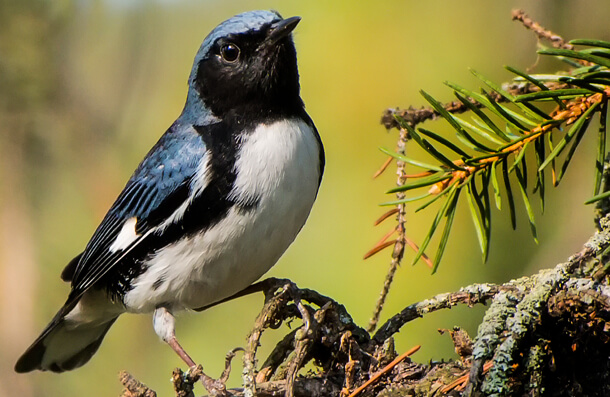Wind Energy Company Sues to Keep Bird Kill Data Out of Public's Hands

Black-throated Blue Warbler is one of many species harmed in unknown numbers at wind-energy facilities. Photo by FotoRequest/Shutterstock.
Contact: Michael Hutchins, Director of ABC's Bird-Smart Wind Energy Program, 202-888-7485
(Washington, D.C., Aug. 24, 2016) An Ohio wind-energy facility doesn't want to reveal how many birds it kills, and has gone to court to keep that information secret. Blue Creek Wind Farm, owned by the Spanish company Iberdrola Renewables, has filed a lawsuit in Ohio to prevent two state agencies from making public what it calls “trade secrets.” The legal action comes after an Ohio bird conservation group, Black Swamp Bird Observatory (BSBO), asked to see bird and bat mortality data for Blue Creek.
The facility went into operation in June 2012. It occupies about 80 square miles in an agricultural area of two Ohio counties rich in bird life. Blue Creek puts larger birds, including raptors, at risk. But it also creates a serious hazard for bats and many smaller bird species, including several of conservation concern. The long list of affected species includes Horned Lark, Killdeer, Golden-crowned Kinglet, Golden-winged Warbler, Black-throated Blue Warbler, Black-and-white Warbler, Philadelphia Vireo, Lapland Longspur, American Tree Sparrow, and Sora, as well as the federally endangered Indiana Bat.
American Bird Conservancy (ABC) strongly believes that the public and environmental groups should have access to reliable data about how many of these birds and bats are killed by the facility, and that the company's attempt to use the legal system to block access would set a dangerous precedent if it succeeds. Mortality data provided by wind-energy companies is notoriously unreliable. ABC has repeatedly called for changes in how and by whom that data is collected, and urged that the more credible and transparent data system used in Hawaii be adopted nationwide. This is the only state where fatality data are collected by independent third-party experts using standardized methods and where the public has access to the information.
“We need greater scientific integrity and transparency in the collection of bird and bat kill data at U.S. wind energy facilities,” said Dr. Michael Hutchins, director of ABC's Bird-Smart Wind Energy Campaign. “Now Iberdrola has sued to keep their data hidden from the public and from conservation organizations. What are they trying to hide?”
The history of the Blue Creek legal action goes back to 2013, when BSBO submitted a Freedom of Information Act request to the U.S. Fish & Wildlife Service (FWS) to find out how many birds and bats were being killed at the site. FWS denied the request, and in 2014 BSBO petitioned the Ohio Department of Natural Resources and the Ohio Power Siting Board to release the data. That triggered the company's current lawsuit against the two agencies.
BSBO is not directly involved in the lawsuit, but its executive director, Kimberly Kaufman, says there's a great deal at stake in the outcome. Kaufman also sits on ABC's board of directors. “Every citizen—birdwatcher or not—should be paying rapt attention to this case,” Kaufman said. “The wind industry is actively working to prevent the public from making informed decisions about these massive machines on our landscape. If they're putting their reputation on the line to hide bird and bat deaths, what else aren't they telling us?”
Blue Creek and other wind-energy facilities should not be able to withhold such vital information about the nation's natural resources, including its birds and bats, Hutchins said. “Our native wildlife does not belong to the wind industry but is owned by the American people and held in trust for future generations,” he said.
Related: See ABC's report on 10 of the worst-sited wind-energy projects for birds.
###
American Bird Conservancy is the Western Hemisphere's bird conservation specialist—the only organization with a single and steadfast commitment to achieving conservation results for native birds and their habitats throughout the Americas. With a focus on efficiency and working in partnership, we take on the toughest problems facing birds today, innovating and building on sound science to halt extinctions, protect habitats, eliminate threats, and build capacity for bird conservation.


















































